Monopolistic Competition
A-level Economics
A real-life market structure?
Monopolistic competition is an odd market structure. On the one hand it resembles some key features of the monopoly market. On the other hand it resembles features of a competitive one.
The conditions of monopolistic competition are:
A degree of product differentiation
A degree of price making power
No or low barriers to entry
These conditions are in no way absolute (which is why I said "a degree"). For example, the monopolistically competitive firm will have a degree of price making power. This means that it has the ability to change its market price but not to the extreme levels a monopoly can. There is still is viable competition in this market, so if the price goes up too much the firm will likely lose too many customers.
You need to understand that there are different outcomes in the short-run and long-run.
The Short-run
The firm is assumed to be a profit maximiser, just like other firms. Therefore, it prices at the point MR=MC.
There is a degree of product differentiation, and just like perfect competition, supernormal profits can be made in the short-run.
This diagram shows the short-run outcome in the monopolistic competition market structure. In the short run, supernormal profit can be made - MR=MC will yield the firm supernormal profits when it is profit maximising.
IF YOU WANT GOOD GRADES FAST, BUY THESE BOOKS!
MACROECONOMICS MODEL ANSWER BOOK
10 Past Papers with Model Answers on the National Economy
Written by an experienced Economics tutor
Full model answers with diagrams
Suitable for all UK Economics exam boards
Physical booklet
£20.00
MICROECONOMICS MODEL ANSWER BOOK
10 Past Papers with Model Answers on Market Failure
Written by an experienced Economics tutor
Full model answers with diagrams
Suitable for all UK Economics exam boards
Physical booklet
£20.00
WANT TO SEE MORE?
The Long-run
So in the short-run, supernormal profits can be made. What happens when people hear about the supernormal profits being made in this industry? People have the incentive to start their own firms and join the market and have a share in the profits. That means new firms are going to enter the market - they can do this easily because there are no or low barriers to entry in this market model.
What happens? Similar to perfect competition, the market supply curve will shift to the right because of the increase in firms. But what happens to the firm's revenue and cost curves?
The AR (Demand) and MR curves will shift to the left - this is because individual firms are losing customers to new firms. The firms will therefore experience a decrease in demand.
Profits will be competed away until the lowest price in the market. The lowest price in the market is the point where AR=AC - the point where normal profits are being made. [remember, normal profit is the minimum amount of profit needed to survive in the long run]
In the long run, the firm will experience an inward shift in its AR=D curve. Because barriers to entry are low, more firms enter the market when they realise supernormal profits can be made. For the firm, the AR=D curve shifts inwards until it is tangent with the ATC curve. It shifts inwards until the point where the price equals the average total cost i.e. normal profits. Therefore, in the long run, normal profits are made due to the existence of low barriers to entry.
Efficiency arguments
As the diagram shows, the firm is producing at the lowest AC, however, the price is above MC. Therefore, the firm is not allocatively efficient.
The firm also can produce at a point where ATC is not minimised (above the point MC=AC). This means the firm is not productively efficient.
The firms are smaller than monopoly firms - this means that they probably won't benefit from economies of scale.
The firm will likely not make large amount of supernormal profit for a very long time. Therefore, the firms will probably not be dynamically efficient.
Whether or not the monopolistically competitive firm is inefficient, it is likely that it will still achieve greater levels of efficiency than a monopoly overall. Prices will be lower and output higher in this market when compared to a pure monopoly - therefore more wants and need are satisfied leading to a better allocation of resources (than a monopoly).
Prices
However, prices will be higher than the perfectly competitive model. This is because the firm doesn't achieve levels of productive efficiency, so ATC is not minimised. It only makes normal profits, but its ATC is higher than it could be.
In the short-run, the firms can make supernormal profits like a monopoly would (especially if the short-run is a long time).
The more differentiated the products in the market, the more inelastic the AR=D curve will be. Therefore, if products are more differentiated, prices will end up being higher.
In summary, we have learned:
Conditions of monopolistic competition
Short-run vs long-run outcomes
Diagrams
Efficiency arguments
Outcome of prices


